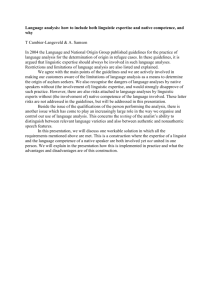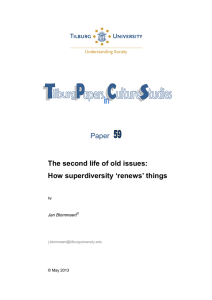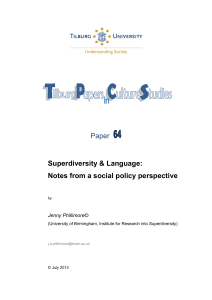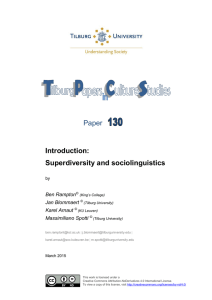Meeting May 21-22, 2015 Tilburg University Abstracts
advertisement
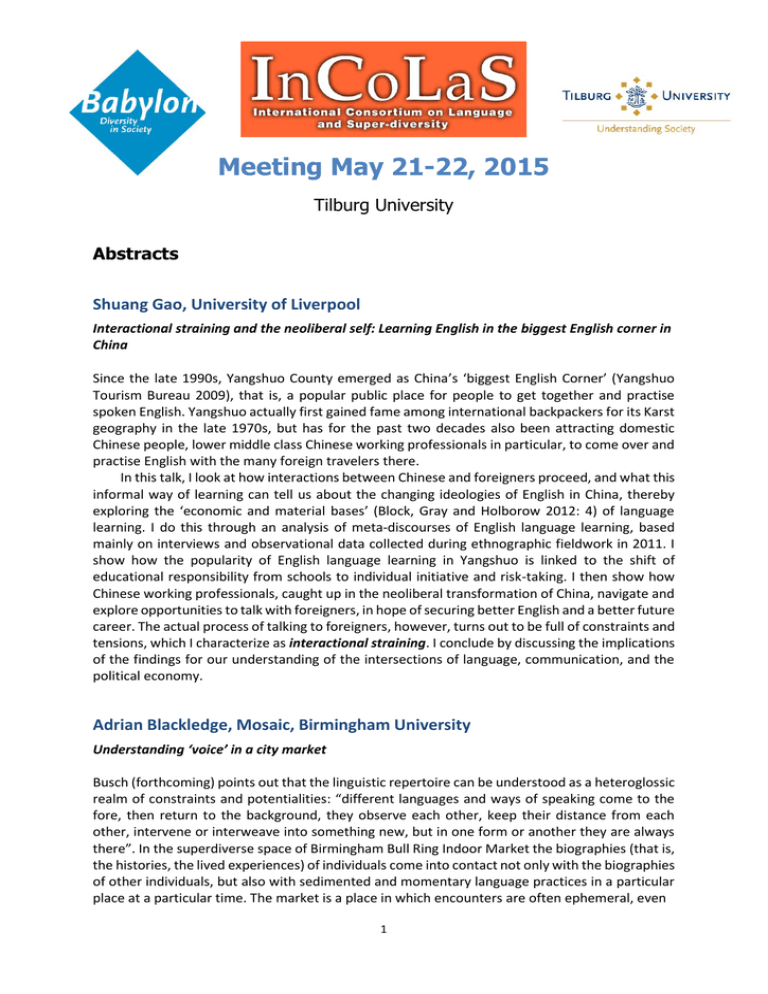
Meeting May 21-22, 2015 Tilburg University Abstracts Shuang Gao, University of Liverpool Interactional straining and the neoliberal self: Learning English in the biggest English corner in China Since the late 1990s, Yangshuo County emerged as China’s ‘biggest English Corner’ (Yangshuo Tourism Bureau 2009), that is, a popular public place for people to get together and practise spoken English. Yangshuo actually first gained fame among international backpackers for its Karst geography in the late 1970s, but has for the past two decades also been attracting domestic Chinese people, lower middle class Chinese working professionals in particular, to come over and practise English with the many foreign travelers there. In this talk, I look at how interactions between Chinese and foreigners proceed, and what this informal way of learning can tell us about the changing ideologies of English in China, thereby exploring the ‘economic and material bases’ (Block, Gray and Holborow 2012: 4) of language learning. I do this through an analysis of meta-discourses of English language learning, based mainly on interviews and observational data collected during ethnographic fieldwork in 2011. I show how the popularity of English language learning in Yangshuo is linked to the shift of educational responsibility from schools to individual initiative and risk-taking. I then show how Chinese working professionals, caught up in the neoliberal transformation of China, navigate and explore opportunities to talk with foreigners, in hope of securing better English and a better future career. The actual process of talking to foreigners, however, turns out to be full of constraints and tensions, which I characterize as interactional straining. I conclude by discussing the implications of the findings for our understanding of the intersections of language, communication, and the political economy. Adrian Blackledge, Mosaic, Birmingham University Understanding ‘voice’ in a city market Busch (forthcoming) points out that the linguistic repertoire can be understood as a heteroglossic realm of constraints and potentialities: “different languages and ways of speaking come to the fore, then return to the background, they observe each other, keep their distance from each other, intervene or interweave into something new, but in one form or another they are always there”. In the superdiverse space of Birmingham Bull Ring Indoor Market the biographies (that is, the histories, the lived experiences) of individuals come into contact not only with the biographies of other individuals, but also with sedimented and momentary language practices in a particular place at a particular time. The market is a place in which encounters are often ephemeral, even 1 where they are serial, and relationships are formed in brief interactions, usually between market traders and customers. However, the fleeting nature of many interactions in the market does not mean that practices do not sediment into registers, or norms, as they are repeated. In the market elaborate performance, including gesture and mime, is a feature of the spatial repertoire, as people with different proficiencies in different languages both communicate by whatever means possible, and entertain themselves and each other. However, the interaction of biographical trajectories and registers is not always a straightforward experience for all concerned. When a shopper found herself without the linguistic capital to engage communicatively with traders she fell back on gesture, but was constrained by powerful ideological norms relating to gender and age, and experienced an everyday interaction as a loss of dignity. When a butcher from Fujian tells the story of the undignified incident in ‘English’ it is at first sight inarticulate and incomprehensible. However, analysis based on Hymesian ethnopoetics reveals the narrative to be a multi-layered, highly-structured, and darkly humorous cautionary tale. This understanding of the narrative suggests implications for research method and analysis. In the fine-grain of communicative interaction in the meat and fish market we can see a world of practices and ideologies which reveal much about human communication in superdiverse cities. Sam Holmes, Kings College, University of London Superdiversity through the backdoor: Enlisting cultural organisations in the shift from a multiculturalism to a superdiversity paradigm in creative multilingual education projects Multiculturalism’s segmentation of languages, cultures and ethnicities does not reflect the nuance and complexity of practices amongst young people in cities like London. While superdiversity provides a more useful theoretical framework for approaching the ethnic and linguistic complexity of individuals, the job remains of translating this into practical applications for institutions such as schools which deal with this on a day-to-day basis. Creative Multilingualism attempts to bring together various grassroots arts/culture/education organisations which are (sometimes unknowingly) at the cutting edge of new practice in multilingual creativity and education. Through an exploratory study and series of collaborative events, a set of theoretical principles is being distilled which underpin current work in this sector. This is intended to serve as a common language for identifying and sharing best practice, as well as promoting the development of new projects and approaches. The superdiversity paradigm, and the kind of educational practice informed by it, currently run counter to the thrust of public policy. However, by engaging directly with schools and organisations on the ground it is possible to largely bypass government in developing projects to cater to the young people concerned. 2 Rob Moore, University of Pennsylvania Learning the Irish language in Protestant East Belfast: A prospectus In November 2011, Linda Ervine, along with other members of the women’s group at her Presbyterian church in East Belfast, organized a six-week “taster course” in Irish (Gaelic), UlsterScots, and Scots Gaelic. The response was enthusiastic, and in 2014 a dedicated Irish language centre called Turas (‘Journey’) opened in the East Belfast Mission on Newtownards Road, with Ms Ervine as Language Development Officer. Over ten weekly Irish language classes are now offered at the centre; 90% of the language learners are Protestant. These activities have generated considerable media attention, not surprisingly given the long association of the Irish language and Republicanism. Ms Ervine, the sister-in-law of unionist politician David Ervine (1953-2007), has come under attack from within the Unionist/Loyalist community, but remains resolute: “The language doesn’t fly a flag, it doesn’t have a political outlook … A language is just a language, and for me it’s the innocent in all of this” (Belfast Telegraph, 9 March 2015). My talk will assess the prospects for a future project of ethnographic research involving the Turas centre as a focal site. A preliminary assessment suggests the presence of themes identified in earlier research on learning the language of an out-group or former enemy in (post-) conflict situations (e.g., Charalambous 2009, Charalambous & Rampton 2010)—but also some significant differences. I will identify a few of these, and sketch some possible directions for further research. Tom Bartlett, Centre for Language and Communication Research, Cardiff University Emergent voices: Popular participation in (super)diverse Centring Institutions In this paper I discuss the conditions for the emergence of new and more collaborative linguistic forms within Centring Institutions (Blommaert 2005:75) that bring socioculturally and linguistically marginalised groups into contact with groups representing the institutional mainstream. Theorising from my fieldwork data in Guyana (Bartlett 2012), I consider a variety of potential relationships between the environmental configuration of the Centring Institutions and the features of discourse produced. I further relate these to consecutive stages through which Centring Institutions might be hypothesised to progress, initially through various manifestations of hybridisation and ultimately onto a relatively settled state definable in its own terms as a new (and more egalitarian) institutional register. While my fieldwork only looked at bicultural environments, I hope to draw generalisations that can be usefully transferred to more diverse contexts as a means of both describing the level and kinds of legitimate polyvocality within specific Centring Institutions and of designing potential collaborative interventions. The paper combines the theoretical and descriptive resources of Systemic Functional Linguistics with wider sociolinguistic research into the concepts of context, voice, indexicality and legitimation. 3 References Bartlett, Tom. 2012. Hybrid Voices and Collaborative Change: Contextualising Positive Discourse Analysis. London and New York: Routledge. Blommaert, J. 2005. Discourse: A Critical Introduction. Cambridge: Cambridge University Press. Kathleen Easlick, University of Manchester Policy approaches and a hierarchy of languages The linguistic challenges facing indigenous and regional minority language groups are similar to those that immigrant language populations face, such as the ability to use one’s language in public administration and access to educational opportunities to learn the language. However, supranational European policy fails to address immigrant languages, despite explicitly responding to regional and indigenous languages. My research focuses on policies related to minority and immigrant languages in the Nordic countries, particularly Finland, and will analyse the ways in which these policies respond to linguistic diversity. Data collected from Finnish legislation, as well as the reports arising from the relevant Council of Europe documents will furnish my analysis. This paper will show that a potential hierarchy of languages can emerge, which may be influential in preventing the allocation and implementation of language resources. In conclusion, this paper will take into consideration theoretical debates on issues of language policies for immigrant languages, such as concerns that all-inclusive policies will prevent adequate provisions for autochthonous languages. 4








